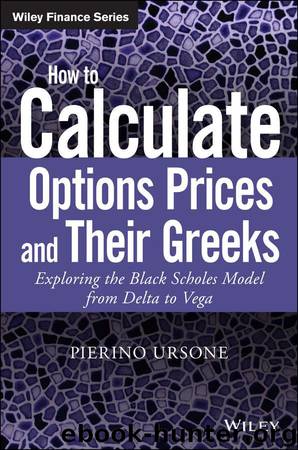How to Calculate Options Prices and Their Greeks: Exploring the Black Scholes Model from Delta to Vega (The Wiley Finance Series) by Ursone Pierino

Author:Ursone, Pierino [Ursone, Pierino]
Language: eng
Format: mobi
ISBN: 9781119011637
Publisher: Wiley
Published: 2015-04-12T23:00:00+00:00
Chart 9.1 Vega distribution
When a trader reports that he is short vega, it means that he has a portfolio with a negative vega, implying that he is short options in general. He will be long vega when being long options in general (There is an exception; in a portfolio with positions in multiple strikes and/or multiple maturities it could happen that a trader is net long options, however short vega. This is a result of either horizontal spreads, time spreads or a combination of the two).
When the vega position/portfolio is stable along a range in the underlying, computing the resulting P&L from a change in volatility is fairly simple. The result will be the change in the market volatility times the vega position, being impacted by that change, as shown in Table 9.2.
Table 9.1 The vega distribution in values from the 36 to 72 strike, Future at 50.00, Volatility 10% and Maturity 1 year
Download
This site does not store any files on its server. We only index and link to content provided by other sites. Please contact the content providers to delete copyright contents if any and email us, we'll remove relevant links or contents immediately.
The Black Swan by Nassim Nicholas Taleb(6763)
Bad Blood by John Carreyrou(6274)
Pioneering Portfolio Management by David F. Swensen(6078)
Millionaire: The Philanderer, Gambler, and Duelist Who Invented Modern Finance by Janet Gleeson(4093)
Skin in the Game by Nassim Nicholas Taleb(3965)
The Money Culture by Michael Lewis(3846)
Bullshit Jobs by David Graeber(3828)
Skin in the Game: Hidden Asymmetries in Daily Life by Nassim Nicholas Taleb(3722)
The Wisdom of Finance by Mihir Desai(3523)
Blockchain Basics by Daniel Drescher(3329)
Liar's Poker by Michael Lewis(3220)
The Intelligent Investor by Benjamin Graham Jason Zweig(2930)
Hands-On Machine Learning for Algorithmic Trading by Stefan Jansen(2925)
Mastering Bitcoin: Programming the Open Blockchain by Andreas M. Antonopoulos(2891)
Fooled by Randomness: The Hidden Role of Chance in Life and in the Markets by Nassim Nicholas Taleb(2860)
Investing For Dummies by Eric Tyson(2793)
The Power of Broke by Daymond John(2772)
Market Wizards by Jack D. Schwager(2538)
Zero Hour by Harry S. Dent Jr. & Andrew Pancholi(2531)
